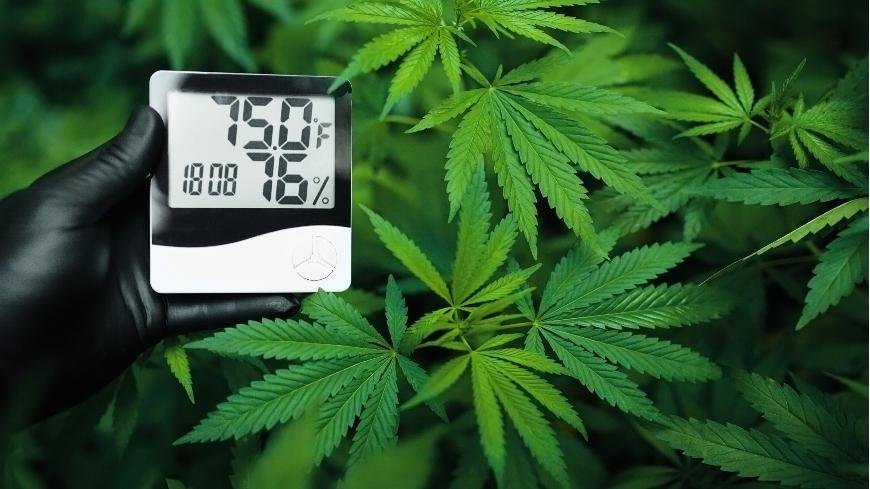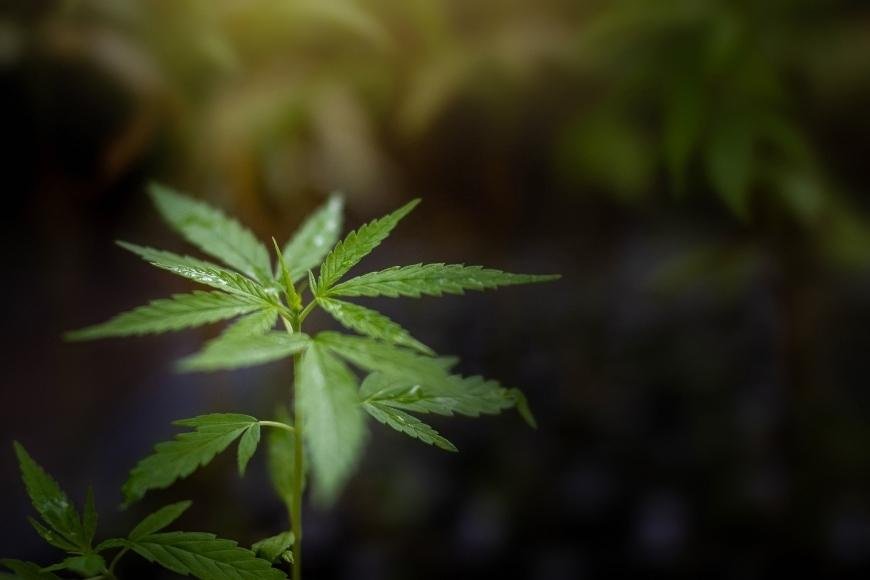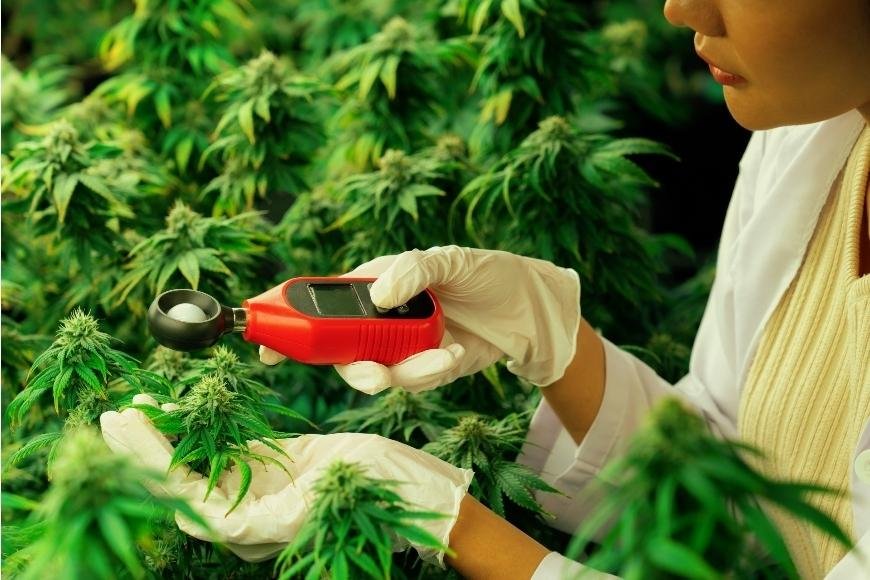Indoor Cannabis Grow: Humidity Guide
Master your garden with our Indoor Cannabis Grow Humidity Guide, exploring optimal levels, control tips, and potential issues for ideal conditions.

When it comes to the Indoor Cannabis Grow Humidity Guide, understanding and controlling humidity levels is crucial for successful cannabis cultivation. In this guide, we'll examine the science of controlling humidity in a cannabis grow room and its effects on plant growth, methods for measuring relative humidity accurately, techniques to keep it at an optimal level during different stages of cultivation, as well as potential benefits or issues from high/low levels.
We'll explore methods for measuring relative humidity accurately, as well as techniques to maintain proper humidity levels throughout different stages of the growing process. Additionally, we will discuss both benefits and potential issues that may arise from high or low humidity levels in your grow space.
By following our expert advice found within this Indoor Cannabis Grow Humidity Guide, you can expect healthier plants with higher yields while avoiding common problems such as bud rot or mold. So let's dive into mastering humidity control for a thriving cannabis garden!
Table of Contents:
- Understanding Humidity in Cannabis Grow Rooms
- Why Humidity Matters for Cannabis Plants
- The Ideal Humidity Range for Different Growth Stages
- The Role of Temperature in Humidity Control
- Measuring Humidity Levels
- Maintaining Proper Humidity Levels
- Benefits of Proper Humidity Control
- Potential Issues from High or Low Humidity Levels
- Tips for Controlling Humidity Levels
- Frequently Asked Questions Indoor Cannabis Grow Humidity Guide
- Conclusion
Understanding Humidity in Cannabis Grow Rooms
Growing cannabis indoors gives you the ultimate control over your plants' environment, allowing you to fine-tune every aspect of their growth. One crucial factor that can significantly impact your cannabis plants' health and yield is humidity. In this section, we'll dive into the importance of humidity control in a cannabis grow room, how it affects plant growth, and why maintaining proper levels is essential for success.
Why Humidity Matters for Cannabis Plants
Humidity denotes the measure of water vapor in the atmosphere encircling your plants. It plays a vital role in several aspects of plant growth:
- Transpiration: High humidity levels slow down transpiration (the process by which plants release moisture through tiny pores called stomata), helping them conserve water and nutrients.
- Nutrient Uptake: Proper humidity allows efficient nutrient uptake through roots, ensuring healthy development and preventing deficiencies or toxicities.
- Pest Prevention: Maintaining optimal humidity helps prevent pests like spider mites from thriving on your cannabis plants.
- Mold Resistance: Controlling humidity reduces the risk of mold formation on buds during flowering stages - a common issue faced by indoor growers.
The Ideal Humidity Range for Different Growth Stages
Different stages of cannabis plant development require varying levels of relative humidity (RH) to thrive optimally. Here's an overview of ideal RH ranges at each stage:
- Vegging Stage: 60-70% RH: During this stage, cannabis plants require higher humidity levels to promote robust vegetative growth and nutrient uptake.
- Flowering Stage: 40-50% RH: Lower humidity is crucial during the flowering phase to prevent mold formation on buds and ensure proper resin production.
- Late Flowering/Drying Stage: 30-40% RH: As harvest approaches, further reducing humidity helps dry out the buds while still preserving their potency and flavor profiles.
In addition to these general guidelines, it's essential to monitor your specific strain's needs and adjust accordingly. For example, some strains may be more susceptible to mold or pests than others at certain humidity levels.

The Role of Temperature in Humidity Control
Besides monitoring relative humidity directly, it's also important to consider how temperature affects moisture content in your grow room air. Warmer air can hold more water vapor than cooler air; thus, maintaining a consistent temperature will help stabilize overall humidity levels as well. Temperature should be kept between 68°F (20°C) and 77°F (25°C), with some adjustments for the plants' growth phases.
To sum up this section:
- Maintaining optimal relative humidity is critical for healthy cannabis plant growth;
- Different stages of development require varying ranges of ideal RH;
- Taking into account strain-specific needs can improve outcomes;
- A stable temperature plays an essential role in controlling overall grow room conditions alongside direct measures like humidifiers or dehumidifiers.
Comprehending the moisture content in a cannabis grow space is critical for prosperous growing, as it can have an impact on the plants' well-being and quality. Measuring humidity levels accurately allows you to adjust conditions accordingly and ensure optimal growth.
Measuring Humidity Levels
Keeping track of humidity levels in your cannabis grow room is crucial for maintaining a healthy environment for your plants. There are several tools available to help you monitor and measure the moisture content in the air, ensuring that you're providing optimal conditions for growth.
Hygrometers: Your Go-To Tool
A hygrometer is an essential tool for measuring humidity levels in your grow room. Analog and digital hygrometers are both available, with the latter often more precise and easier to interpret than their analog equivalents, thus making them a preferred option among cultivators. Digital hygrometers, boasting higher accuracy and greater readability than analog models, are often the preferred choice of growers.
Selecting the Right Hygrometer
- Accuracy: Look for a hygrometer with an accuracy rating of ±1% or better to ensure precise readings.
- Ease of use: Choose a device with user-friendly features like large displays and easy-to-navigate menus.
- Durability: Opt for high-quality materials that can withstand the moist environment of a grow room without succumbing to corrosion or damage over time.
- Add-on features: Some hygrometers also include temperature sensors, which can be helpful since both temperature and humidity play vital roles in plant health.
Tips on Using Your Hygrometer Effectively
- Pick strategic locations: To get accurate readings throughout your grow space, place multiple hygrometers at different spots within the area - ideally, one near the canopy, another in the middle of the room, and a third close to your intake vents.
- Calibrate regularly: To ensure accurate readings over time, calibrate your hygrometer every few months using a salt test or calibration kit. Check out this guide on how to calibrate a hygrometer.
- Monitor daily: Check humidity levels at least once per day - more frequently during critical growth stages like germination and flowering when optimal conditions are crucial for success.
Incorporating these tips into your grow routine will help you maintain proper humidity levels throughout each stage of plant development. By staying vigilant about monitoring moisture content in the air, you'll be well-equipped to create an ideal environment for thriving cannabis plants.
Maintaining Proper Humidity Levels
Controlling humidity levels during different stages of cannabis plant growth is essential for a successful grow. This section will explain how to maintain proper humidity levels at each stage, ensuring your plants thrive and produce high-quality buds.
Seedling Stage
In the seedling stage, young cannabis plants require higher humidity levels to support their development. Aim for a relative humidity (RH) level between 65% and 70%. A humidifier can be used to raise the air's moisture content if required.
Vegetative Stage
As your plants transition into the vegetative stage, they'll need slightly lower humidity levels than before. Keep RH between 55% and 60% during this phase. Adjust your humidifier settings or introduce fresh air from outside using an air duct system if necessary.
- TIP: Be cautious when introducing outdoor air as it may contain pests or pathogens that could harm your plants.
Flowering Stage
The flowering stage requires even lower humidity levels to prevent mold growth on dense buds. Maintain RH between 40% and 50%. You might need to invest in a dehumidifier to reduce moisture in the grow room during this stage.
Late Flowering Stage
In the final weeks of flowering, lower humidity levels even further to around 30% - 40%. This helps plants focus on producing resinous trichomes and reduces the risk of mold. Continue using a dehumidifier or increase ventilation with fans for optimal results.
Maintaining proper humidity levels throughout each growth stage is crucial for healthy cannabis plants. By following these guidelines, you'll create an ideal environment that promotes vigorous growth and minimizes potential issues like mold or plant stress.
Benefits of Proper Humidity Control
Controlling humidity levels in your cannabis grow room is essential for ensuring healthy plant growth and maximizing yields. When you maintain the right balance, you'll enjoy several benefits that will make your indoor growing experience more rewarding.
Better Nutrient Uptake
Maintaining proper humidity levels allows cannabis plants to efficiently absorb nutrients through their roots and leaves. High humidity can cause nutrient deficiencies, while low humidity may lead to overfeeding issues. For flourishing growth, providing your plants with the correct conditions can help them absorb all their necessary nutrients.
Fewer Pests and Diseases
- Pest prevention: Many common pests like spider mites thrive in low-humidity environments. By maintaining appropriate moisture levels, you'll create an environment less conducive to these unwanted guests.
- Disease control: Mold and mildew are two major threats to cannabis plants that prefer high-humidity conditions. Keeping relative humidity within the recommended range helps prevent these diseases from taking hold in your grow room.
Increase Resin Production & Terpenes Profile
A well-regulated environment promotes higher resin production on buds as well as richer terpenes profiles - both crucial factors contributing to potency and aroma of your final product. Environmental conditions, such as temperature and humidity, have a significant influence on the potency of cannabis. So, proper humidity control can directly impact the quality of your cannabis.
Optimal Growth and Yield
Ultimately, maintaining appropriate humidity levels throughout each stage of growth will help ensure that your plants reach their full potential. This means larger buds, more potent flowers, and higher overall yields for you to enjoy. A well-regulated grow room environment is essential for getting the most out of your indoor cannabis cultivation efforts.
Potential Issues from High or Low Humidity Levels
Being aware of the potential issues that may result from high or low humidity levels is key for successful cannabis cultivation, and we'll explore common problems as well as how to address them. In this section, we'll explore the potential issues associated with both high and low humidity levels, as well as how to address them.
Mold and Mildew Growth
High humidity levels create a perfect environment for mold and mildew growth. These fungi thrive in damp conditions and can quickly spread throughout your grow room if left unchecked. Mold not only damages your cannabis plants but also poses health risks when consumed. To prevent mold growth, ensure adequate air circulation by using fans and maintain ideal humidity levels during different stages of plant growth. You may find this guide on preventing mold in cannabis cultivation helpful.
Bud Rot
Bud rot is another issue caused by excessive moisture in the grow room environment. This fungus attacks the buds from within, causing them to turn brownish-grey with a slimy texture before eventually crumbling away entirely - rendering your harvest useless. Keep an eye out for any signs of bud rot as early detection allows you to take action before it spreads further into other parts of the plant or even neighboring plants too. Learn more about bud rot identification and prevention here.
Plant Stress Due to Low Humidity Levels
- Vapor Pressure Deficit (VPD): If there isn't enough moisture in the air around your cannabis plants due to low relative humidity, it can lead to a condition called Vapor Pressure Deficit (VPD). VPD affects the rate at which plants transpire, leading to slower growth and reduced yields.
- Nutrient Uptake Issues: Low humidity levels can also impact nutrient uptake by cannabis plants. Low humidity can impede the roots' capacity to absorb nutrients properly, leading to deficiencies that hamper plant growth and development. To avoid this issue, monitor humidity levels closely and make necessary adjustments as needed.
Pest Infestations
Humidity imbalances can also contribute to pest infestations such as spider mites or whiteflies - both of which thrive under specific environmental conditions. For example, spider mites prefer low humidity environments while whiteflies are attracted to high humidity areas. Regularly inspect your plants for any signs of pests and treat them accordingly with organic pesticides or beneficial insects if required.
Being conscious of the issues that can result from too much or too little humidity in an indoor cannabis grow is essential, as it could have a major effect on your plants. To ensure optimal growing conditions and prevent any problems, tips for controlling humidity levels should be followed closely.

Tips for Controlling Humidity Levels
Here are some practical tips and tricks you can use to maintain optimal humidity levels throughout the different stages of your plants' life cycle:
1. Use a humidifier or dehumidifier
Humidifiers and dehumidifiers are essential tools for controlling humidity in your grow space. A humidifier adds moisture to the air while a dehumidifier works to reduce it. Choose the proper equipment depending on if you require to raise or lower the relative humidity in your grow space.
2. Monitor temperature and ventilation
Maintaining proper temperature and ventilation is key to managing humidity levels effectively. Warmer temperatures can hold more moisture, so make sure that you have adequate airflow through exhaust fans, intake vents, and oscillating fans inside the growing area.
3. Adjust watering practices accordingly
Your watering habits can significantly impact indoor cannabis grow room's humidity levels as well; overwatering may lead to higher-than-desired relative humidity (RH). Be mindful of how much water you're giving your plants - too little or too much could cause issues with RH balance.
- Vegging stage: During this phase, young cannabis plants require higher RH (around 60-70%). Water them regularly but avoid over-saturating their medium.
- Blooming stage: As your plants transition to the flowering phase, they will need a lower RH (around 40-50%). Reduce watering frequency and volume accordingly.
4. Utilize air conditioning or heating systems
Air conditioners and heaters can also help control humidity levels in your grow room by regulating temperature. Be sure to monitor their usage closely, as excessive use of either system could lead to an imbalance in relative humidity.
5. Seal your grow space properly
An improperly sealed grow area can allow moisture from outside sources to infiltrate the space, leading to fluctuations in humidity levels. Make sure that all windows, doors, and vents are adequately sealed with weatherstripping or other appropriate materials.
6. Consider using hygrometers for precise monitoring
Hygrometers are devices used for measuring relative humidity accurately within a given environment; investing in one is essential for maintaining proper cannabis growth conditions throughout different stages of development.
Frequently Asked Questions Indoor Cannabis Grow Humidity Guide
What is the ideal humidity for growing cannabis indoors?
The ideal humidity for growing cannabis indoors varies depending on the growth stage. During the vegetative stage, maintain a relative humidity (RH) of 40-70%, with temperatures between 68-77°F (20-25°C). In the flowering stage, reduce RH to 40-50% and keep temperatures around 64-75°F (18-24°C).
Is 60% humidity too high for flowering?
A relative humidity of 60% during the flowering phase may be slightly too high. It's recommended to maintain an RH level between 40%-50%. High humidity can lead to mold or bud rot issues in your plants.
What is the ideal temperature and humidity for flowering cannabis?
The optimal conditions for flowering cannabis are maintaining a temperature range of 64-75°F (18-24°C) and a relative humidity level between 40%-50%. These conditions promote healthy plant development while minimizing risks associated with mold or other diseases.
What is an acceptable humidity to dry cannabis?
An acceptable drying environment should have a relative humidity level of around 55%, along with temperatures ranging from 65-74°F(18-23°C). This allows buds to dry slowly without promoting mold growth, ensuring maximum potency and flavor preservation.
Conclusion
By following the tips outlined in this indoor cannabis grow humidity guide, growers can ensure that their plants are receiving optimal moisture and air circulation to reach full maturity. Maintaining proper humidity levels will help prevent issues such as mold or plant stress due to high or low humidity levels. With careful monitoring and adjusting of the environment accordingly, any grower can create a successful harvest with quality results.























































































































